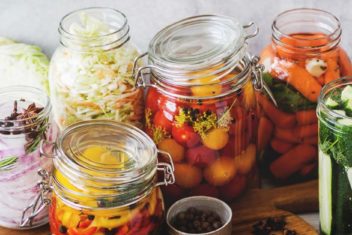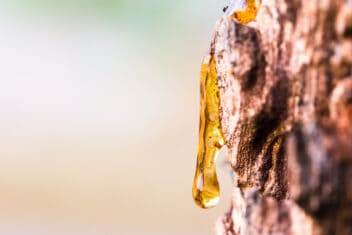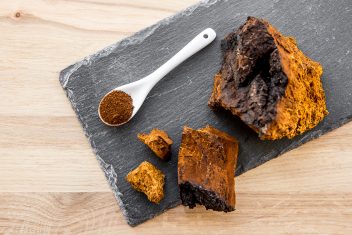If you’re anything like me, the word “nightshade” conjures images of witches’ sabbats, bottled poisons, and intrigues. It’s hard to see “nightshade” on the page and not write “deadly” in front of it.
All in all, nightshades are a complex, nuanced group of plants. They offer a myriad of benefits and a few significant risks. They have a dark reputation and a cozy, down-home image as essentials in the all-American garden.
But some nightshades have remained on the borders. Black nightshade is one of those plants.
Let’s separate fact from fiction.
What are Nightshades?
Black nightshade is one of the most commonly consumed plants in other parts of the world, but it’s still misunderstood in North America.
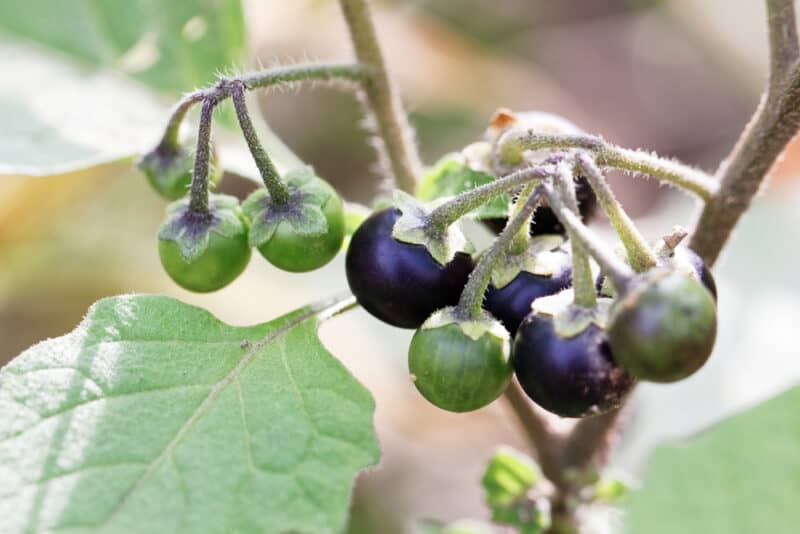
To put it simply, nightshades are plants in the Solanaceae family.
Black nightshades are the species Solanum americanum, S. nigrum and S. ptychanthum, and other species that aren’t common. They’re all related to both deadly nightshade and tomatoes, but most people in North America consider them a dangerous, potentially deadly weed. Let’s get to the truth:
Despite the darker images it calls to mind, nightshades aren’t all deadly. Our gardens are full of happy, healthy nightshade plants. Tomatoes, potatoes, peppers, and eggplant are all members of the nightshade family.
Some of them even have toxic elements of their own.
It’s hard to think of potatoes or tomatoes as dangerous, but people feared them when they were first introduced. Unripe potatoes are highly toxic, but we don’t rip the plants out of the garden when we see them.
Tomatoes fruits are safe, but tomato leaves have been reported to cause the same cardiac and hallucinogenic issues as deadly nightshade (Atropa belladonna). That seems to be inaccurate, though.
A New York Times article reports that tomato leaves are edible for both humans and animals. People and animals throughout the world eat them without ill effects.
Having said that, I once found my ducks lying dazed in the yard – hearts fluttering, eyes unfocused – after eating tomato leaves. Only one duck died, but the survivors seemed determined to repeat their wild “trip.”
So obviously, there is lots of misinformation out there that tells you to run away from nightshade, but does it deserve its reputation?
Get to Know Black Nightshade
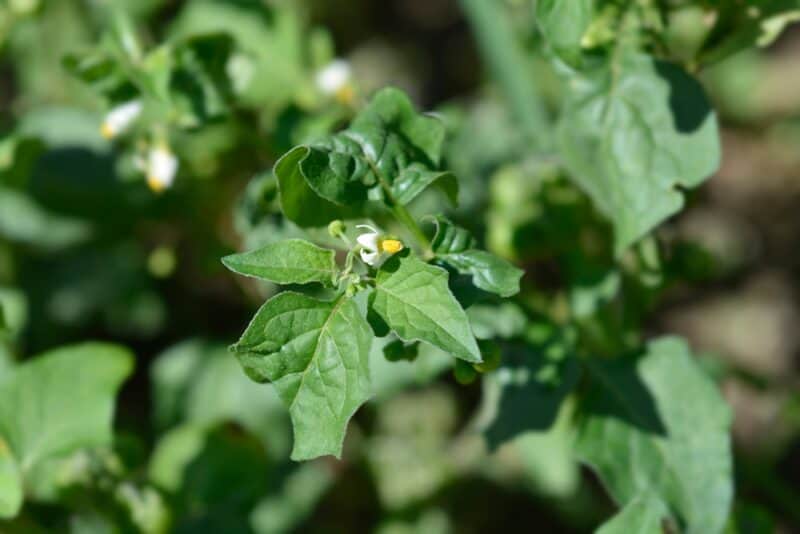
When I first saw black nightshade referred to specifically, I assumed it was just another name for deadly nightshade. But black nightshade is a little more complex and a lot less dangerous. The truth is, “black nightshade” is a catch-all term for a few different nightshade species.
Most of our cultivated botany in North America comes through western European channels. Those Europeans were familiar with a species of nightshade they called “black nightshade” because of their dark, purple-black berries.
European black nightshade (S. nigrum) has been considered safe for certain uses throughout European history. When those same Europeans began exploring the world around them and writing home about it, they discovered that black nightshade existed worldwide.
Whether in North Africa, India, or North America, these explorers found a local weed that looked and acted almost identical to European black nightshade. Naturally, they continued to refer to these new plants as black nightshade.
American nightshade (S. americanum) and West Indian nightshade (S. ptychanthum) are two common nightshades that grow wild in the Americas. Together with S. nigrum, they belong to the “black nightshade complex” of plants.
There are quite a few plants in this complex, spread worldwide. But these three nightshades are a part of the wild, North American landscape.
Can I Forage for Black Nightshade?
Nightshades present a few challenges for foragers. Most importantly, remember that all nightshade plants contain solanine. Solanine is a toxic compound that causes heart palpitations, hallucinations, and sometimes death.
All nightshade plants contain solanine in at least part of the plant. But that doesn’t mean you can’t consume parts of the plant. Remember, potatoes and tomatoes contain solanine, too, and we eat those.
Solanine 101
Plants like deadly nightshade contain large amounts of solanine throughout the leaves and berries, while nightshades like tomatoes contain smaller amounts of solanine in the leaves and stem. Potatoes have a higher amount, similar to that in black nightshade.
In wild nightshades, these solanine levels can vary drastically depending on an abundance of unknowable factors. Everything from the plant’s genetic history to the soil quality, to the weather, can impact solanine levels.
While challenging growing conditions like poor soil and drought tend to increase solanine levels, there is no way to judge whether one plant contains high or low levels of solanine.
Black nightshade plants contain solanine in the aerial parts (leaves, stems, and flowers) and unripe berries. As the berries ripen, their solanine drastically reduces.
Ripe berries still contain small amounts of solanine (so do tomatoes and potatoes), but the levels are negligible if you eat the berries in moderation.
You can also safely eat a small number of young leaves, and you can boil the older leaves to remove the solanine.
Recognizing Black Nightshade
Another challenge in foraging for black nightshade is recognition. The world is full of nightshades – many are dangerous, and others are safe. If our ancestors had never explored the differences between various nightshades, our diets would be much less interesting.
Wild nightshades share a lot of similar traits. If you’re foraging for black nightshades, you should know what all three common black nightshades look like. But you should also be comfortable recognizing deadly nightshade, woody nightshade, and other dangerous look-alikes.
Black nightshades share a few apparent features. They all have black berries (when the berries are ripe) and long, ovular leaves that resemble a pepper or potato plant. All the black nightshades grow to between a foot and 30 inches in height. But each variety is slightly different.
American Nightshade
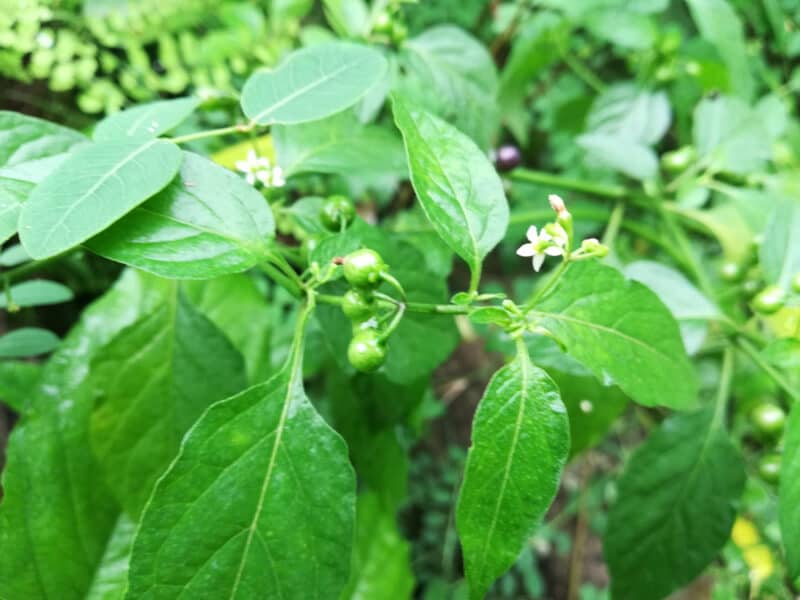
American nightshade stands out because its stem is not hairy. While some nightshades have stems similar to tomatoes or potatoes, with a coating of fine hairs all over the stem, American nightshade is almost smooth.
The berries start out green with flecks of white. Later, they ripen to a shiny black. Of the three common nightshades in North America, S. americanum has the shiniest berries.
These berries also grow in an umbral cluster (think umbrella). This means that the stems of all the berries go back to a central stem, giving them an umbrella shape.
West Indian Nightshade
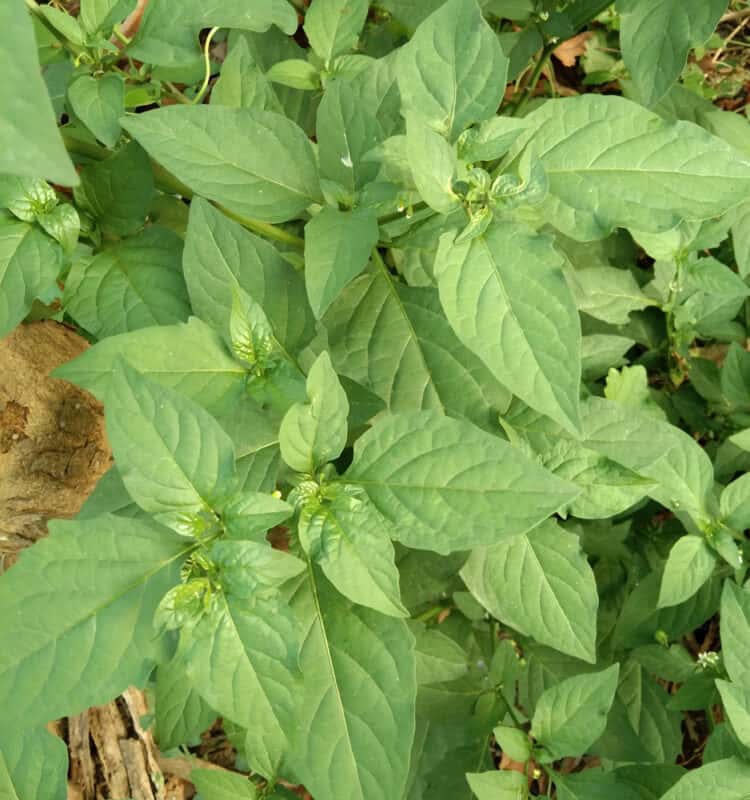
West Indian nightshade looks almost exactly like American nightshade. So much so that many botanists wonder if S. ptychanthum is simply a cross between S. americanum and S. nigrum. Nobody really knows.
While its berries are usually a bit less shiny, the primary difference between the two species is in the leaves.
Young S. ptychanthum leaves are maroon. Look at the new growth and sprouts carefully, turning the leaves over. If there’s a dull, reddish, or maroon tint to the leaf, you’re likely looking at West Indian nightshade rather than American nightshade.
European Nightshade
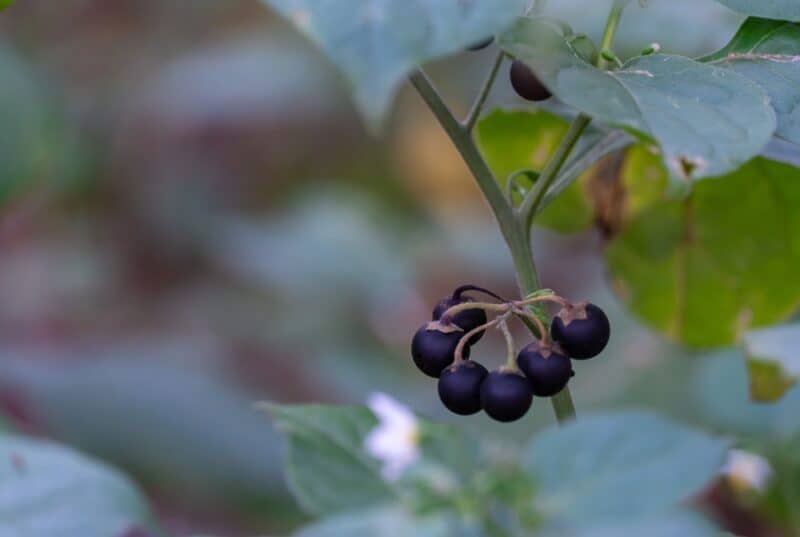
European black nightshade naturalized quickly in the New World. S. nigrum is common throughout North America but looks slightly different from its American cousins.
European black nightshade produces dull, black berries. They aren’t shiny and don’t grow in an umbral cluster. Instead, their stems are staggered along a stem. The berries are also slightly larger than either of the other nightshades.
European black nightshade is also slightly hairier than American nightshades. It is not extremely hairy like hairy nightshade (S. physalifolium) is. But you’ll notice a bit more hairiness on S. nigrum than you will on either S. ptychanthum or S. americanum.
Deadly Nightshade
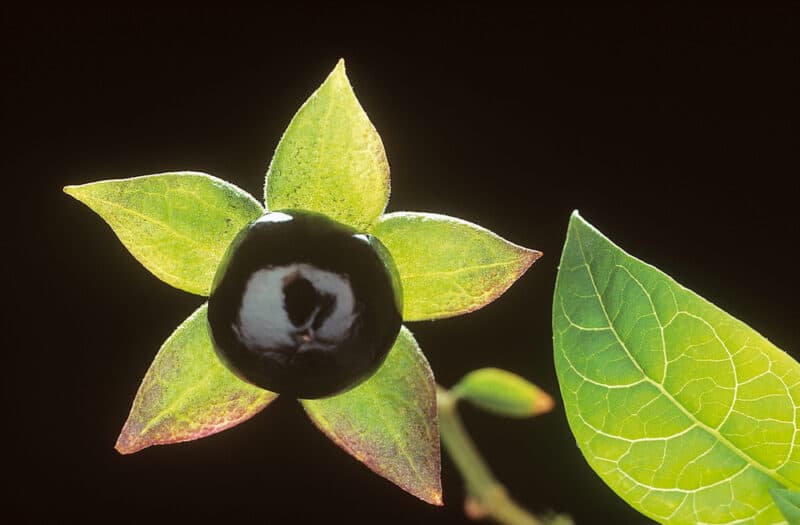
The most important plant to be able to recognize is deadly nightshade. You want to avoid this one at all cost.
Atropa belladonna is native to Europe and Asia, but it has naturalized in some disturbed areas in North America, particularly in coastal areas.
The most significant difference between deadly and black nightshade is that the berries grow singly rather than in clusters.
The calyx, which is the green “hat” like part that sits between the stem and the berry, is larger than the berry in deadly nightshade. It extends beyond the berry. In black nightshade, the calyx is smaller than the berry.
Deadly nightshade flowers are generally larger and dark purple or pale lavender. Black species have small white flowers.
Using Black Nightshade Berries
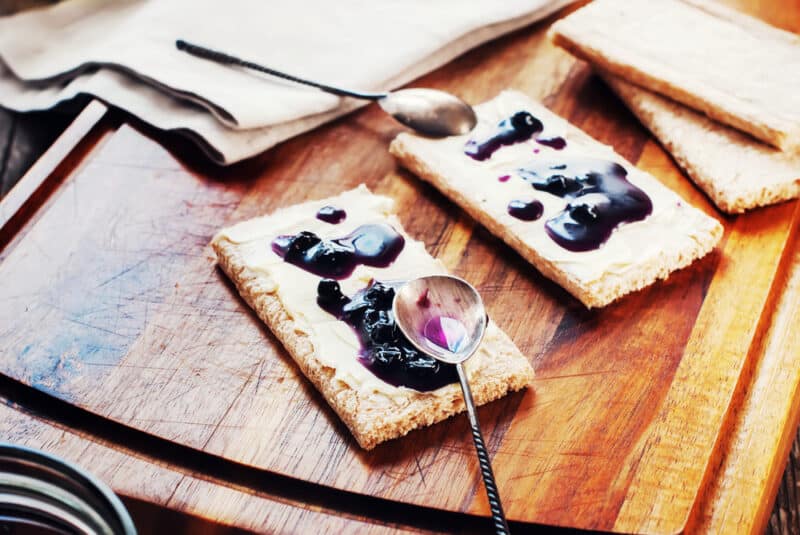
While foragers often use all three species of black nightshade, they aren’t all equally popular. American nightshade seems to be both more plentiful and more generally considered safe.
Fully ripe, the berries of all three species are tasty and flavorful. Numerous studies have shown that moderate consumption of ripe berries is safe.
While Euell Gibbons confidently ate black nightshade berry pies, most foragers chose to be a little more cautious in their consumption. Instead of a full pie, try making black nightshade jam. It’s a fun way to add a little nightshade berry flavor to your meal.
You can eat the ripe berries raw, which is how most foragers consume them.
Black Nightshade Greens
Now, here’s where the daredevil foragers take a left turn and start experimenting. Black nightshade berries have a long history of safe use in western traditions. But, there are rumors that black nightshade leaves can also be eaten safely.
In fact, people around the world eat them every day.
Wait! Don’t run out and munch one now. Let’s look at the information first.
People who eat black nightshade leaves don’t eat them raw. Instead, they boil the leaves – twice – for 15 minutes each time and drain the water out each time. American nightshade seems to come out on top as far as edible greens are concerned.
European nightshade comes in second with a tradition of being eaten in some African countries. West Indian nightshade is less well-documented. Rumors abound that some Native American tribes have eaten it for centuries, but there aren’t many clear sources on that front.
Cooking Black Nightshade Greens
If you decide to eat black nightshade greens, try American nightshade first. Cut only young leaves. As the leaves get older, they build up more and more solanine. Harvest young leaves before the whole plant blooms. Don’t harvest leaves from plants in flower or plants with ripe berries.
When you have the leaves, boil them in water for 15 minutes. Then, discard the water and add fresh water to the pot. Boil the leaves in fresh water for another 15 minutes. Drain the water and eat the greens.
They’re nutritionally similar to amaranth, though they’re a little less rich in vitamins A and C. Unless you’re starving out in the woods with plenty of water and a strong fire, or you’re a huge fan of boiled greens, I’d encourage you to eat berries and avoid greens.
But many foragers swear by the stuff, and if you’re looking for a nutritious source of food, black nightshade is an edible option.



